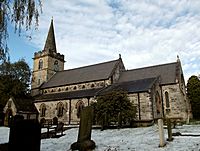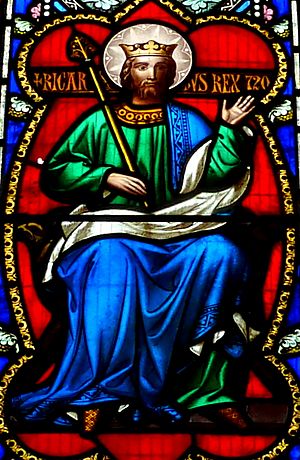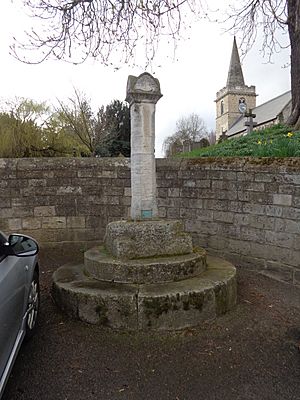St Ricarius Church, Aberford facts for kids
Quick facts for kids St Ricarius Church, Aberford |
|
|---|---|
| Church of St Ricarius or St Riquier | |
 |
|
| 53°49′44″N 1°20′38″W / 53.828854°N 1.343817°W | |
| Location | Aberford, West Yorkshire |
| Country | England |
| Denomination | Church of England |
| History | |
| Status | Parish Church |
| Architecture | |
| Heritage designation | Grade II listed building |
| Architect(s) | Anthony Salvin |
| Completed | 1861 |
| Specifications | |
| Materials | Magnesian limestone |
| Administration | |
| Province | York |
The Church of St Ricarius is a historic church located in Aberford, a village in West Yorkshire, England. It is an active Anglican church, meaning it belongs to the Church of England. People often say the church is named after a French saint called St Richarius (or Riquier), who might have visited Aberford way back in the year 630.
However, there's also a beautiful stained glass window inside the church. This window shows "Ricarius Rex 720," which means King Richard from the year 720. This King Richard is also known as St Richard the Pilgrim, a Saxon king. So, the church's name might be linked to him instead!
Contents
Church History
Most of the Church of St Ricarius you see today was rebuilt in 1861. An architect named Anthony Salvin designed this rebuilding. Before that, it was a 12th-century church.
Some parts of the older church still remain. These include the tower, which was built in the Norman style, and one Norman window. There's also a window from the 13th century. The church was officially recognized as a Grade II listed building on February 3, 1967. This means it's an important historical building that needs to be protected.
Church Design and Features
Outside the Church
The church is built from a type of stone called magnesian limestone. Its roof is made of slate. The tower on the west side has a short, eight-sided spire. This spire looks like the one from the old church. The tower has three levels. The bottom part is made of rough stones, and the upper parts are made of neatly cut stones.
The belfry, where the bells are, has round-headed windows in the Norman style on all sides of its top level. There's also a clock face on the east side of the tower. The church has a main area called the nave, with side sections called north and south aisles. There's a small entrance porch on the south side. The church also has a north vestry (a room for clergy) and a small chancel (the area around the altar) with a south chapel. The chapel has a small door and window for the priest. The porch has a sundial that dates back to 1806.
Inside the Church
Inside, the church has rows of arches called arcades. These arches have a special shape with two sloped edges and rest on short, round columns. The arch leading to the chancel has a painting from the 20th century. There are also two arches on each side of the chancel. On the north side, there's a narrow, pointed Norman window. This window might have been moved from the older church.
The church also holds the anvil of a famous blacksmith named Samuel Hick. He is buried outside the church. You can also see an eight-sided stone font, which is used for baptisms. It has a beautifully carved wooden cover.
Market Cross
Just outside the church's south gate, there's an old market cross. People believe it was first made in the 17th century. It was moved to this spot in 1911. Like the church, the cross is made of magnesian limestone.
The cross stands on two round steps and has a stone base with an eight-sided bottom part. There's a brass plaque with writing on it. It says the cross was taken away during the plague in 1644. It was then fixed up and moved here to celebrate the coronation of King George V in 1911.
Images for kids
See also
- List of places of worship in the City of Leeds
- Listed buildings in Aberford









